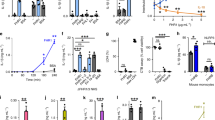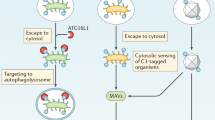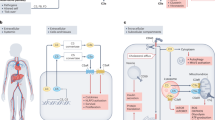Abstract
Rapid phagocytosis of apoptotic cells is thought to limit the development of inflammation and autoimmune disease. Serum enhances macrophage phagocytosis of apoptotic cells. Here we identified protein S as the factor responsible for serum-stimulated phagocytosis of apoptotic cells. Protein S is best known for its anti-thrombotic activity, serving as a cofactor for protein C. Purified protein S was equivalent to serum in its ability to stimulate macrophage phagocytosis of apoptotic lymphoma cells, and immunodepletion of protein S eliminated the prophagocytic activity of serum. Protein S acted by binding to phosphatidylserine expressed on the apoptotic cell surface. Protein S is thus a multifunctional protein that can facilitate clearance of early apoptotic cells in addition to regulating blood coagulation.
This is a preview of subscription content, access via your institution
Access options
Subscribe to this journal
Receive 12 print issues and online access
$209.00 per year
only $17.42 per issue
Buy this article
- Purchase on Springer Link
- Instant access to full article PDF
Prices may be subject to local taxes which are calculated during checkout





Similar content being viewed by others
References
Savill, J. & Fadok, V. Corpse clearance defines the meaning of cell death. Nature 407, 784–788 (2000).
Shacter, E., Williams, J.A., Hinson, R.M., Senturker, S. & Lee, Y.J. Oxidative stress interferes with cancer chemotherapy: inhibition of lymphoma cell apoptosis and phagocytosis. Blood 96, 307–313 (2000).
Scaffidi, P., Misteli, T. & Bianchi, M.E. Release of chromatin protein HMGB1 by necrotic cells triggers inflammation. Nature 418, 191–195 (2002).
Scott, R.S. et al. Phagocytosis and clearance of apoptotic cells is mediated by MER. Nature 411, 207–211 (2001).
Cohen, P.L. et al. Delayed apoptotic cell clearance and lupus-like autoimmunity in mice lacking the c-mer membrane tyrosine kinase. J. Exp. Med. 196, 135–140 (2002).
Fadok, V.A. et al. Exposure of phosphatidylserine on the surface of apoptotic lymphocytes triggers specific recognition and removal by macrophages. J. Immunol. 148, 2207–2216 (1992).
Verhoven, B., Schlegel, R.A. & Williamson, P. Mechanisms of phosphatidylserine exposure, a phagocyte recognition signal, on apoptotic T lymphocytes. J. Exp. Med. 182, 1597–1601 (1995).
Martin, S.J. et al. Early redistribution of plasma membrane phosphatidylserine is a general feature of apoptosis regardless of the initiating stimulus: inhibition by overexpression of Bcl-2 and Abl. J. Exp. Med. 182, 1545–1556 (1995).
Moffatt, O.D., Devitt, A., Bell, E.D., Simmons, D.L. & Gregory, C.D. Macrophage recognition of ICAM-3 on apoptotic leukocytes. J. Immunol. 162, 6800–6810 (1999).
Anderson, H.A., Englert, R., Gursel, I. & Shacter, E. Oxidative stress inhibits the phagocytosis of apoptotic cells that have externalized phosphatidylserine. Cell. Death Differ. 9, 616–625 (2002).
Fadok, V.A. et al. A receptor for phosphatidylserine-specific clearance of apoptotic cells. Nature 405, 85–90 (2000).
Devitt, A. et al. Human CD14 mediates recognition and phagocytosis of apoptotic cells. Nature 392, 505–509 (1998).
Ogden, C.A. et al. C1q and mannose binding lectin engagement of cell surface calreticulin and CD91 initiates macropinocytosis and uptake of apoptotic cells. J. Exp. Med. 194, 781–796 (2001).
Platt, N., Suzuki, H., Kurihara, Y., Kodama, T. & Gordon, S. Role for the class A macrophage scavenger receptor in the phagocytosis of apoptotic thymocytes in vitro. Proc. Natl. Acad. Sci. USA 93, 12456–12460 (1996).
Savill, J., Dransfield, I., Hogg, N. & Haslett, C. Vitronectin receptor-mediated phagocytosis of cells undergoing apoptosis. Nature 343, 170–173 (1990).
Finnemann, S.C. & Rodriguez-Boulan, E. Macrophage and retinal pigment epithelium phagocytosis: apoptotic cells and photoreceptors compete for αvβ3 and αvβ5 integrins, and protein kinase C regulates αvβ5 binding and cytoskeletal linkage. J. Exp. Med. 190, 861–874 (1999).
Albert, M.L., Kim, J.I. & Birge, R.B. αvβ5 integrin recruits the CrkII-Dock 180-rac1 complex for phagocytosis of apoptotic cells. Nat. Cell Biol. 2, 899–905 (2000).
Esmon, C.T. Regulation of blood coagulation. Biochim. Biophys. Acta. 1477, 349–360 (2000).
Dahlback, B. Blood coagulation. Lancet 355, 1627–1632 (2000).
Thomas, R.H. Hypercoagulability syndromes. Arch. Intern. Med. 161, 2433–2439 (2001).
Merrill, J.T. What causes the antiphospholipid syndrome? Curr. Rheumatol. Rep. 3, 293–300 (2001).
Rand, J.H. Molecular pathogenesis of the antiphospholipid syndrome. Circ. Res. 90, 29–37 (2002).
Mevorach, D., Mascarenhas, J.O., Gershov, D. & Elkon, K.B. Complement-dependent clearance of apoptotic cells by human macrophages. J. Exp. Med. 188, 2313–2320 (1998).
Esmon, C.T. The roles of protein C and thrombomodulin in the regulation of blood coagulation. J. Biol. Chem. 264, 4743–4746 (1989).
Nelsestuen, G.L., Kisiel, W. & Di Scipio, R.G. Interaction of vitamin K dependent proteins with membranes. Biochem. 17, 2134–2138 (1978).
Walker, F.J. Regulation of activated protein C by a new protein. A possible function for bovine protein S. J. Biol. Chem. 255, 5521–5524 (1980).
May, W.S. &. Cuatrecasas, P. Transferrin receptor: its biological significance. J. Membr. Biol. 88, 205–215 (1985).
Stenflo, J. Contributions of Gla and EGF-like domains to the function of vitamin K- dependent coagulation factors. Crit. Rev. Eukary. Gene Expr. 9, 59–88 (1999).
Carreras, L.O. & Forastiero, R.R. Pathogenic role of antiprotein-phospholipid antibodies. Haemostasis 26 (Suppl. 4) 340–357 (1996).
Gal, A. et al. Mutations in MERTK, the human orthologue of the RCS rat retinal dystrophy gene, cause retinitis pigmentosa. Nat. Genet. 26, 270–271 (2000).
Krahling, S., Callahan, M.K., Williamson, P. & Schlegel, R.A. Exposure of phosphatidylserine is a general feature in the phagocytosis of apoptotic lymphocytes by macrophages. Cell Death Differ. 6, 183–189 (1999).
Stitt, T.N. et al. The anticoagulation factor protein S and its relative, Gas6, are ligands for the Tyro 3/Axl family of receptor tyrosine kinases. Cell 80, 661–670 (1995).
Esmon, C.T. Inflammation. They're not just for clots anymore. Curr. Biol. 5, 743–746 (1995).
Godowski, P.J. et al. Reevaluation of the roles of protein S and Gas6 as ligands for the receptor tyrosine kinase Rse/Tyro 3. Cell 82, 355–368 (1995).
Ishimoto, Y., Ohashi, K., Mizuno, K. & Nakano, T. Promotion of the uptake of PS liposomes and apoptotic cells by a product of growth arrest-specific gene, gas6. J. Biochem. (Tokyo) 127, 411–717 (2000).
Hall, M.O. et al. Outer segment phagocytosis by cultured retinal pigment epithelial cells requires Gas6. Exp. Eye Res. 73, 509–520 (2001).
Lu, Q. et al. Tyro-3 family receptors are essential regulators of mammalian spermatogenesis. Nature 398, 723–728 (1999).
Balasubramanian, K., Chandra, J. & Schroit, A.J. Immune clearance of phosphatidylserine-expressing cells by phagocytes. The role of β2-glycoprotein I in macrophage recognition. J. Biol. Chem. 272, 31113–31117 (1997).
Savill, J., Hogg, N., Ren, Y. & Haslett, C. Thrombospondin cooperates with CD36 and the vitronectin receptor in macrophage recognition of neutrophils undergoing apoptosis. J. Clin. Invest. 90, 1513–1522 (1992).
Hanayama, R. et al. Identification of a factor that links apoptotic cells to phagocytes. Nature 417, 182–187 (2002).
Lee, Y.J. & Shacter, E. Oxidative stress inhibits apoptosis in human lymphoma cells. J. Biol. Chem. 274, 19792–19798 (1999).
Chang, M.K. et al. Monoclonal antibodies against oxidized low-density lipoprotein bind to apoptotic cells and inhibit their phagocytosis by elicited macrophages: evidence that oxidation-specific epitopes mediate macrophage recognition. Proc. Natl. Acad. Sci. USA 96, 6353–6358 (1999).
Acknowledgements
We thank V. Calvert for supplying human monocytes; E. Shores and G. Tosato for critical reading of the manuscript; and E. Petricoin and Y. M. Zhao for expert technical advice.
Author information
Authors and Affiliations
Corresponding author
Ethics declarations
Competing interests
The authors declare no competing financial interests.
Supplementary information
Web Fig. 1.
Identification of protein S in the prophagocytic serum fraction. (a) Two-dimensional gel of the purified fraction stained with Coomassie blue. Proteins that were identified by tandem mass spectrometry (MS) are indicated (Pr.S, protein S; Kin., kininogen, BSA, bovine serum albumin). (b) MS spectra of tryptic digests of the Coomassie blue-stained protein S spot. CID represents collision-induced dissociation of peptide analyzed in c. (c) MS/MS profile analysis of ion 908.50 identifying protein S from the unique peptide sequence VYFAGVPR. Peptides from kininogen (YSIVFIAR) and BSA (KVPQVSTPTLVEVSR) were analyzed similarly (data not shown). (PDF 162 kb)
Web Fig. 2.
Immunoanalysis of protein S in enriched phagocytosis fraction. Proteins from serum (25 μg), the purified prophagocytic fraction from serum (5 μg) and human protein S (5 μg) were resolved by SDS-PAGE and stained for protein with Sypro Ruby Protein Gel Stain (Molecular Probes). Immunoblotting of proteins transferred to PVDF membranes was performed using a rabbit anti-protein S IgG primary antibody followed by HRP-conjugated goat anti-rabbit IgG. The three polypeptides seen in the commercial human protein S preparation and the differences in molecular weight observed between bovine and human protein S are most likely attributed to the numerous post-translational modifications that are known to occur to this molecule (for example, proteolysis, glycosylation, γ-glutamyl carboxylation). (PDF 195 kb)
Rights and permissions
About this article
Cite this article
Anderson, H., Maylock, C., Williams, J. et al. Serum-derived protein S binds to phosphatidylserine and stimulates the phagocytosis of apoptotic cells. Nat Immunol 4, 87–91 (2003). https://doi.org/10.1038/ni871
Received:
Accepted:
Published:
Issue Date:
DOI: https://doi.org/10.1038/ni871
This article is cited by
-
Identification and verification of feature biomarkers associated with immune cells in neonatal sepsis
European Journal of Medical Research (2023)
-
Receptor tyrosine kinases Tyro3, Axl, and Mertk differentially contribute to antibody-induced arthritis
Cell Communication and Signaling (2023)
-
Therapeutic targeting of the functionally elusive TAM receptor family
Nature Reviews Drug Discovery (2023)
-
Internalization of apoptotic cells during efferocytosis requires Mertk-mediated calcium influx
Cell Death & Disease (2023)
-
LncRNA RP3-525N10.2-NFKB1-PROS1 triplet-mediated low PROS1 expression is an onco-immunological biomarker in low-grade gliomas: a pan-cancer analysis with experimental verification
Journal of Translational Medicine (2022)



